不定式用法总结
- 格式:ppt
- 大小:182.50 KB
- 文档页数:15
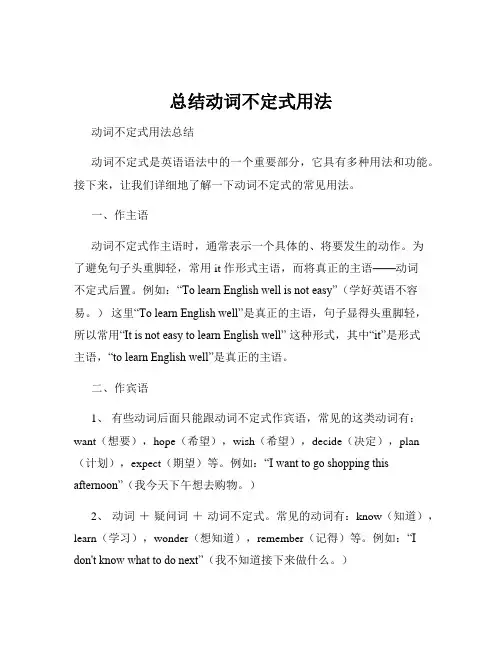
总结动词不定式用法动词不定式用法总结动词不定式是英语语法中的一个重要部分,它具有多种用法和功能。
接下来,让我们详细地了解一下动词不定式的常见用法。
一、作主语动词不定式作主语时,通常表示一个具体的、将要发生的动作。
为了避免句子头重脚轻,常用 it 作形式主语,而将真正的主语——动词不定式后置。
例如:“To learn English well is not easy”(学好英语不容易。
)这里“To learn English well”是真正的主语,句子显得头重脚轻,所以常用“It is not easy to learn English well” 这种形式,其中“it”是形式主语,“to learn English well”是真正的主语。
二、作宾语1、有些动词后面只能跟动词不定式作宾语,常见的这类动词有:want(想要),hope(希望),wish(希望),decide(决定),plan (计划),expect(期望)等。
例如:“I want to go shopping this afternoon”(我今天下午想去购物。
)2、动词+疑问词+动词不定式。
常见的动词有:know(知道),learn(学习),wonder(想知道),remember(记得)等。
例如:“I don't know what to do next”(我不知道接下来做什么。
)三、作宾语补足语1、常见的动词如:ask(要求),tell(告诉),want(想要),teach(教),allow(允许)等后面常接动词不定式作宾语补足语。
例如:“The teacher asked us to finish the homework on time”(老师要求我们按时完成作业。
)2、一些使役动词和感官动词如:make(使,让),let(让),have(使,让),see(看见),hear(听见),feel(感觉)等,在主动语态中,接不带 to 的动词不定式作宾语补足语;但在被动语态中,要加上 to。
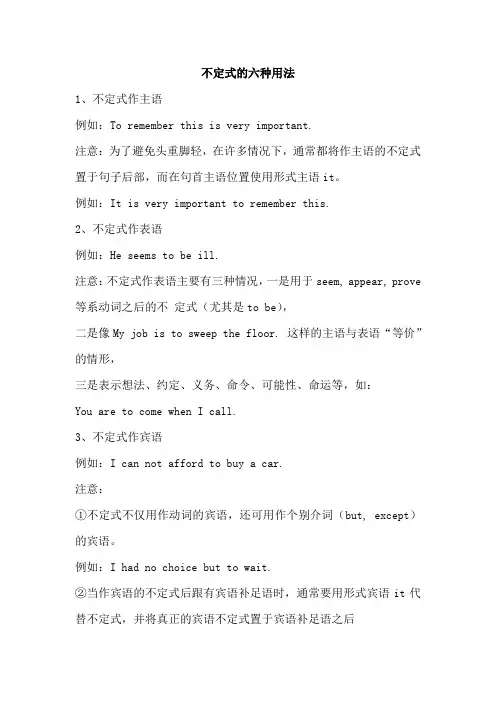
不定式的六种用法1、不定式作主语例如:To remember this is very important.注意:为了避免头重脚轻,在许多情况下,通常都将作主语的不定式置于句子后部,而在句首主语位置使用形式主语it。
例如:It is very important to remember this.2、不定式作表语例如:He seems to be ill.注意:不定式作表语主要有三种情况,一是用于seem, appear, prove 等系动词之后的不定式(尤其是to be),二是像My job is to sweep the floor. 这样的主语与表语“等价”的情形,三是表示想法、约定、义务、命令、可能性、命运等,如:You are to come when I call.3、不定式作宾语例如:I can not afford to buy a car.注意:①不定式不仅用作动词的宾语,还可用作个别介词(but, except)的宾语。
例如:I had no choice but to wait.②当作宾语的不定式后跟有宾语补足语时,通常要用形式宾语it代替不定式,并将真正的宾语不定式置于宾语补足语之后例如:I find it difficult to learn Japanese well.4、不定式作宾语补足语例如:Who taught you to drive?5、不定式作定语例如:I have a question to ask you.注意:有的名词(如way, chance, right等)后用作不定式可换成of doing sth.如:It is the best way to do (of doing) it.但是以下名词后接不定式作定语时通常不能换成of doing sth. attempt courage decision effort fortune failure invitation wish6、不定式作状语例如:I went to France to learn French.。
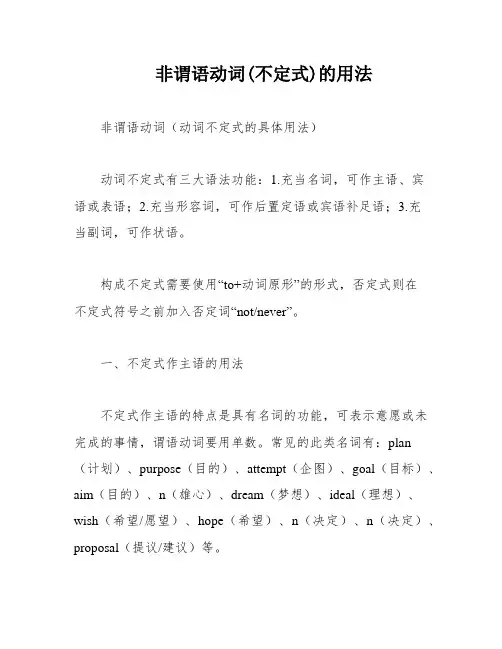
非谓语动词(不定式)的用法非谓语动词(动词不定式的具体用法)动词不定式有三大语法功能:1.充当名词,可作主语、宾语或表语;2.充当形容词,可作后置定语或宾语补足语;3.充当副词,可作状语。
构成不定式需要使用“to+动词原形”的形式,否定式则在不定式符号之前加入否定词“not/never”。
一、不定式作主语的用法不定式作主语的特点是具有名词的功能,可表示意愿或未完成的事情,谓语动词要用单数。
常见的此类名词有:plan(计划)、purpose(目的)、attempt(企图)、goal(目标)、aim(目的)、n(雄心)、dream(梦想)、ideal(理想)、wish(希望/愿望)、hope(希望)、n(决定)、n(决定)、proposal(提议/建议)等。
为了避免主语过长,不定式短语可放在句末,用形式主语“it”代替原来的主语位置,不定式则成为真正的主语。
例如:___.(赢得冠军是我的雄心。
)To master a foreign language is necessary.(掌握一门外语是有必要的。
)To e President of the United States used to be my goal.(过去我的梦想是成为美国总统。
)Speaking perfect English is always my dream.(说一口流利的英语一直是我的梦想。
)It is ___.(保护环境是有必要的。
)There are two special ___:1) It is + adj + of sb + to do sth.2) It is + adj + for sb + to do sth.___ characteristics and differences are:1) If ___ characteristics or traits。
the logical subject of the ___ "of."Examples:It is very affable of you to help me。

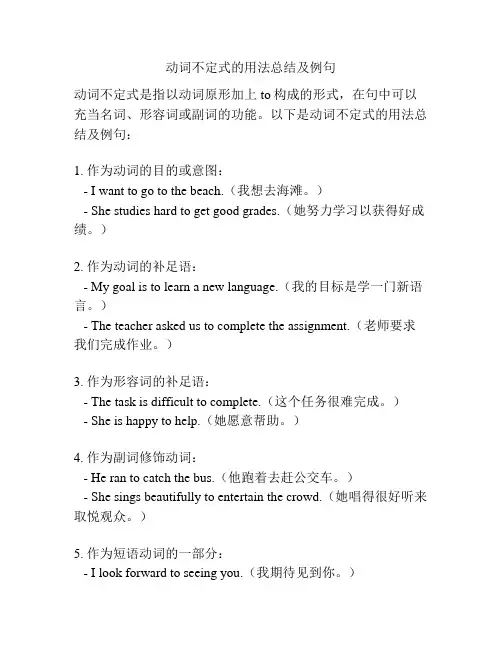
动词不定式的用法总结及例句动词不定式是指以动词原形加上to构成的形式,在句中可以充当名词、形容词或副词的功能。
以下是动词不定式的用法总结及例句:1. 作为动词的目的或意图:- I want to go to the beach.(我想去海滩。
)- She studies hard to get good grades.(她努力学习以获得好成绩。
)2. 作为动词的补足语:- My goal is to learn a new language.(我的目标是学一门新语言。
)- The teacher asked us to complete the assignment.(老师要求我们完成作业。
)3. 作为形容词的补足语:- The task is difficult to complete.(这个任务很难完成。
)- She is happy to help.(她愿意帮助。
)4. 作为副词修饰动词:- He ran to catch the bus.(他跑着去赶公交车。
)- She sings beautifully to entertain the crowd.(她唱得很好听来取悦观众。
)5. 作为短语动词的一部分:- I look forward to seeing you.(我期待见到你。
)- He decided to give up smoking.(他决定戒烟。
)6. 作为动词的主语:- To live a healthy lifestyle is important.(过健康的生活方式很重要。
)- To travel the world is his dream.(环游世界是他的梦想。
)7. 作为动词的宾语:- I like to read novels.(我喜欢读小说。
)- They want to visit their grandparents.(他们想去拜访祖父母。
)需要注意的是,动词不定式在句中的位置可以灵活变化,但通常放在动词之后、名词之前、或者作为句子的结尾。
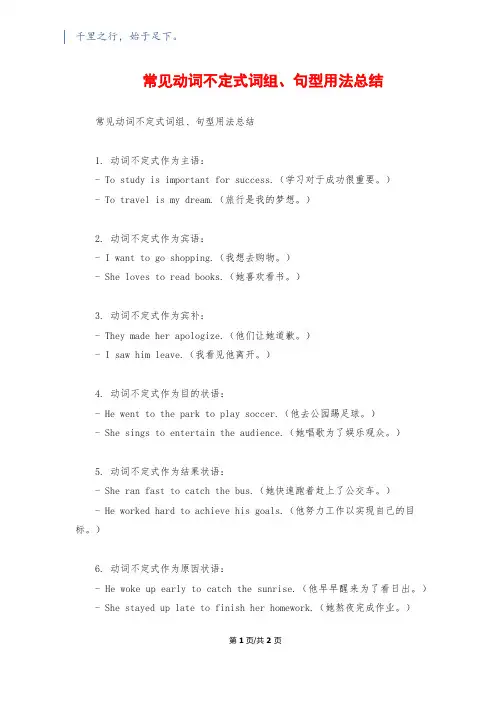
千里之行,始于足下。
常见动词不定式词组、句型用法总结常见动词不定式词组、句型用法总结1. 动词不定式作为主语:- To study is important for success.(学习对于成功很重要。
)- To travel is my dream.(旅行是我的梦想。
)2. 动词不定式作为宾语:- I want to go shopping.(我想去购物。
)- She loves to read books.(她喜欢看书。
)3. 动词不定式作为宾补:- They made her apologize.(他们让她道歉。
)- I saw him leave.(我看见他离开。
)4. 动词不定式作为目的状语:- He went to the park to play soccer.(他去公园踢足球。
)- She sings to entertain the audience.(她唱歌为了娱乐观众。
)5. 动词不定式作为结果状语:- She ran fast to catch the bus.(她快速跑着赶上了公交车。
)- He worked hard to achieve his goals.(他努力工作以实现自己的目标。
)6. 动词不定式作为原因状语:- He woke up early to catch the sunrise.(他早早醒来为了看日出。
)- She stayed up late to finish her homework.(她熬夜完成作业。
)第1页/共2页锲而不舍,金石可镂。
7. 动词不定式作为条件状语:- If you want to succeed, you must work hard.(如果你想成功,你必须努力。
)- You have to practice every day to improve your English.(你必须每天练习才能提高英语。
)8. 动词不定式作为伴随状语:- She listened to music to relax.(她听音乐放松。

动词不定式的用法总结动词不定式在中学英语中应用非常广泛,一方面在句中可起名词、形容词或副词的作用,同时也可在句中作主语、宾语、定语、状语和宾语补足语。
接下来为大家提供了以下:动词不定式的用法总结一动词不定式的形式一般是to +动词原形,但to有时要省去。
而动词不定式在具体运用时用不用to,取决于谓语动词的用法。
现就以下几方面介绍如下。
一、不定式结构1. 带to的不定式结构能直接跟带to的不定式结构的动词主要有:want, ask, tell, hope, learn, try, decide, forget, remember, like, love, stop, go, come等。
如:I want to go to the movies with you.我想跟你一起去看电影。
Don’t forget to turn off the light before you leave.在你离开之前别忘了关灯。
注意:动词不定式的否定形式是在不定式前直接加not,即not to do sth.。
如:Dave told me not to wake up Kate.大卫告诉我别叫醒凯特。
2. 不带to的不定式结构以下几种情况使用不带to的动词不定式:(1)在固定词组had better之后。
注意:had better的否定形式是had better not do sth.。
如:You had better go home now.你最好现在回家。
It’s cold outside. You’d better not go out.外面很冷,你最好不要出去。
(2)在let, make, see, feel, watch, hear等感官或使役动词后,要跟不带to的动词不定式作宾语补足语。
如:I made them give me the money back.我迫使他们把钱还给我。
I didn’t see you come in.我没看见你进来。

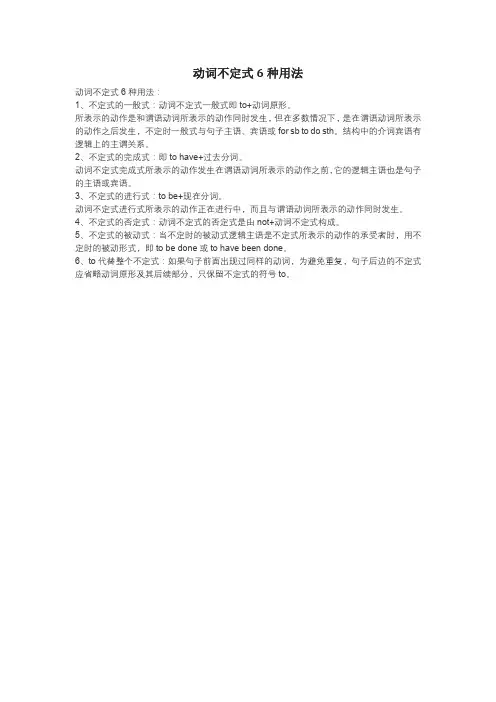
动词不定式6种用法
动词不定式6种用法:
1、不定式的一般式:动词不定式一般式即to+动词原形。
所表示的动作是和谓语动词所表示的动作同时发生,但在多数情况下,是在谓语动词所表示的动作之后发生,不定时一般式与句子主语、宾语或for sb to do sth。
结构中的介词宾语有逻辑上的主谓关系。
2、不定式的完成式:即to have+过去分词。
动词不定式完成式所表示的动作发生在谓语动词所表示的动作之前,它的逻辑主语也是句子的主语或宾语。
3、不定式的进行式:to be+现在分词。
动词不定式进行式所表示的动作正在进行中,而且与谓语动词所表示的动作同时发生。
4、不定式的否定式:动词不定式的否定式是由not+动词不定式构成。
5、不定式的被动式:当不定时的被动式逻辑主语是不定式所表示的动作的承受者时,用不定时的被动形式,即to be done或to have been done。
6、to代替整个不定式:如果句子前面出现过同样的动词,为避免重复,句子后边的不定式应省略动词原形及其后续部分,只保留不定式的符号to。
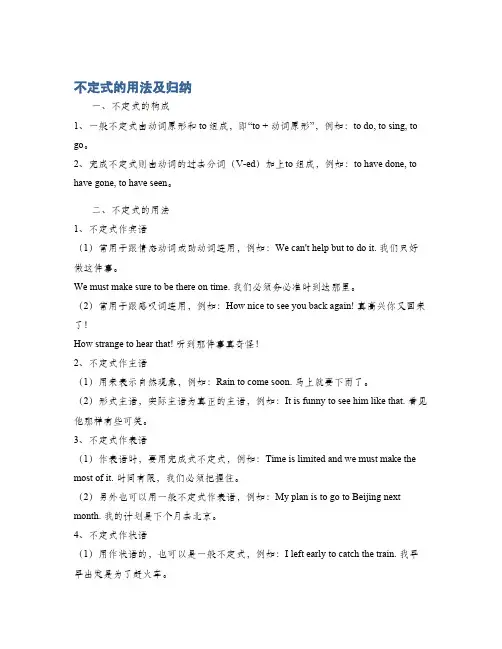
不定式的用法及归纳一、不定式的构成1、一般不定式由动词原形和to组成,即“to + 动词原形”,例如:to do, to sing, to go。
2、完成不定式则由动词的过去分词(V-ed)加上to组成,例如:to have done, to have gone, to have seen。
二、不定式的用法1、不定式作宾语(1)常用于跟情态动词或助动词连用,例如:We can't help but to do it. 我们只好做这件事。
We must make sure to be there on time. 我们必须务必准时到达那里。
(2)常用于跟感叹词连用,例如:How nice to see you back again! 真高兴你又回来了!How strange to hear that! 听到那件事真奇怪!2、不定式作主语(1)用来表示自然现象,例如:Rain to come soon. 马上就要下雨了。
(2)形式主语,实际主语为真正的主语,例如:It is funny to see him like that. 看见他那样有些可笑。
3、不定式作表语(1)作表语时,要用完成式不定式,例如:Time is limited and we must make the most of it. 时间有限,我们必须把握住。
(2)另外也可以用一般不定式作表语,例如:My plan is to go to Beijing next month. 我的计划是下个月去北京。
4、不定式作状语(1)用作状语的,也可以是一般不定式,例如:I left early to catch the train. 我早早出发是为了赶火车。
(2)另外,也有完成不定式用作状语,使句子更加丰满,例如:She looked around, having entered the room. 她走进房间后,四下张望。
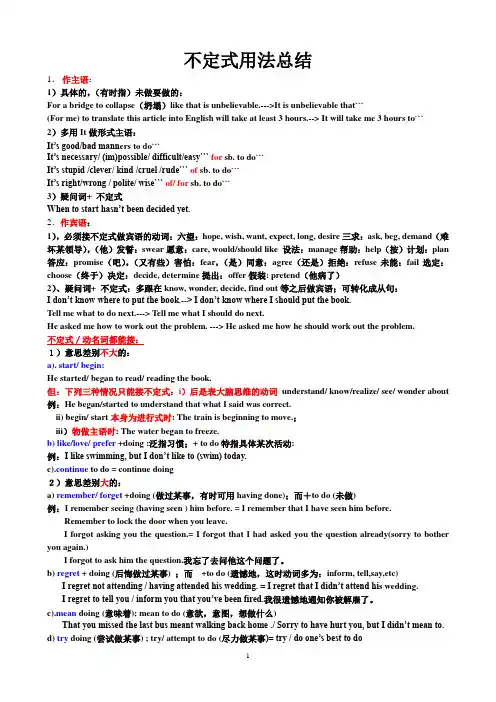
不定式用法总结1.作主语:1)具体的,(有时指)未做要做的:For a bridge to collapse(坍塌)like that is unbelievable.--->It is unbelievable that```(For me) to translate this article into English will take at least 3 hours.--> It will take me 3 hours to```2)多用It做形式主语:It’s good/bad mann ers to do```It’s necessary/ (im)possible/ difficult/easy``` for sb. to do```It’s stupid /clever/ kind /cruel /rude``` of sb. to do```It’s right/wrong / polite/ wise``` of/ for sb. to do```3)疑问词+ 不定式When to start hasn’t been decided yet.2.作宾语:1),必须接不定式做宾语的动词:六望:hope, wish, want, expect, long, desire三求:ask, beg, demand(难坏某领导),(他)发誓:swear愿意:care, would/should like 设法:manage帮助:help(按)计划:plan 答应:promise(吧),(又有些)害怕:fear,(是)同意:agree(还是)拒绝:refuse未能:fail选定:choose(终于)决定:decide, determine提出:offer假装: pretend(他病了)2)、疑问词+ 不定式:多跟在know, wonder, decide, find out等之后做宾语;可转化成从句:I don’t know where to put the book.--> I don’t know where I should put the book.Tell me what to do next.---> Tell me what I should do next.He asked me how to work out the problem. ---> He asked me how he should work out the problem.不定式/动名词都能接:1)意思差别不大的:a). start/ begin:He started/ began to read/ reading the book.但:下列三种情况只能接不定式:i)后是表大脑思维的动词understand/ know/realize/ see/ wonder about 例:He began/started to understand that what I said was correct.ii) begin/ start本身为进行式时: The train is beginning to move.;iii)物做主语时: The water began to freeze.b) like/love/ prefer +doing :泛指习惯;+ to do特指具体某次活动:例:I like swimming, but I don’t like to (swim) today.c).continue to do = continue doing2)意思差别大的:a) remember/ forget +doing (做过某事,有时可用having done);而+to do (未做)例:I remember seeing (having seen ) him before. = I remember that I have seen him before.Remember to lock the door when you leave.I forgot asking you the question.= I forgot that I had asked you the question already(sorry to bother you again.)I forgot to ask him the question.我忘了去问他这个问题了。
动词不定式的用法动词不定式由to+动词原形构成。
这里的to是不定式标志,没有词义。
一、各种形式1. 基本形式:to+动词原形2. 否定形式:not to donever to do二、用法(一)作主语(谓语动词常用单数)1. 位于句首To keep a pet is interesting.养宠物时间有趣的事。
To get up early is a good habit.早起是个好习惯。
2. 位于句末⑴It's+adj./n.+todo sth.It's easy to make friends with him.和他交朋友很容易。
It's interesting to play games with kids.和孩子们玩游戏很有趣。
It's my dream to be a pilot.成为飞行员是我的梦想。
⑵It's+adj.+for sb.+to do sth.It's not easy for me to make friends.对我来说,交朋友不太容易。
It's possible for humans to fly to the moon.对于人类而言,飞上月球是可能的。
⑶It's+adj.+of sb.+todo sth.=sb.+be+adj.+to do sth.It's very kind of you to help us.=You are kind to help us.小结训练1. It's our duty _________ the room every day.A. to cleanB. cleanedC. cleanD. cleans(甘肃省)2. It's hard for us _________ English well.A. learnB. learnsC. to learnD. learning(江西省)3.建造这座立交桥将花费工人们一年多的时间。
不定式用法归纳Mar 5, 2011主要用法:1)主语2)表语3)宾语4)宾补5)定语6)状语7)疑问词+不定式8)不定式复合结构9)不定式主动表被动10) it指代不定式11)不定式时态12)不定式的省略一.做主语To see is to believe.It feels good to be out here for a walk.二.作表语To see is to believe.My wish is to live peacefully.三.做宾语I want to make a call.He managed to pass the driving test.区别:try to do / doing努力做/尝试做stop to do / doing停下一件事去做另一件事/停下正在做的事remember (forget, regret) to do / doing没有做用to do;做过了用doingmean to do / doing打算做/意味着go on to do / doing接着做另一件事/继续做同一件事四.做宾补感官动词/使役动词+宾语+do(这里免to的不定式作宾补)常用的感官动词:see, hear, feel常用的使役动词:have, letThey knew her very well. They had seen her grow up from childhood.As you’ve never been here before, I’ll have someone show you the way. (90上海)The mother felt herself grow cold and her hands trembled as she read the letter from the battlefield. (2006上海)五.作定语用法1:不定式和被修饰词之间有动宾关系。
初中英语不定式用法总结1.不定式的构成不定式的基本形式为:to+动词原形,有时可以不用to,这里的to是不定式符号,本身无词义,动词不定式的否定形式是“not + (to+)动词原形”。
2.不定式的功能(1)不定式作主语动词不定式作主语时,常用it作形式主语,而将真正的主语后置。
如:To learn English well is useful.=It is useful to learn English well.It's important for us to protect the environment.(2)不定式作宾语①不定式用在及物动词后作宾语,常见的及物动同有:begin,choose,continue,decide,expect,fail,forget,hate,help,hope,learn,manage,mean,need,offer,plan,prefer,pretend,promise,refuse,try,want,wish,determine,afford,agree,start,likeShe promised to come at nine o'clock. 她答应九点来的。
I have decided to study English.我已决定学英语了②在find,think后跟不定式作宾语时,常用it代替,而将真正的宾语放在后面。
如:I find it very easy to read English every day.我认为每天读英语很简单。
③常见的一些接不带to的动词不定式的结构Why not do...,Why don't you do...,had better ( not) do...Would rather do,Could/Would/Will you please ( not) do...如:I would rather stay in the room.我宁愿待在房间里。
不定式用法归纳Mar 5, 2011主要用法:1) 主语2) 表语3) 宾语4) 宾补5) 定语6) 状语7) 疑问词+ 不定式8) 不定式复合结构9) 不定式主动表被动10) it指代不定式11) 不定式时态12) 不定式的省略一. 做主语To see is to believe.It feels good to be out here for a walk.二. 作表语To see is to believe.My wish is to live peacefully.三. 做宾语I want to make a call.He managed to pass the driving test.区别:try to do / doing 努力做/ 尝试做stop to do / doing 停下一件事去做另一件事/ 停下正在做的事remember (forget, regret) to do / doing 没有做用to do; 做过了用doingmean to do / doing 打算做/ 意味着go on to do / doing 接着做另一件事/ 继续做同一件事四. 做宾补感官动词/ 使役动词+ 宾语+ do (这里免to 的不定式作宾补)常用的感官动词:see, hear, feel常用的使役动词:have, letThey knew her very well. They had seen her grow up from childhood.As you’ve never been here before, I’ll have someone show you the way. (90上海)The mother felt herself grow cold and her hands trembled as she read the letter from the battlefield. (2006上海)五. 作定语用法1:不定式和被修饰词之间有动宾关系。